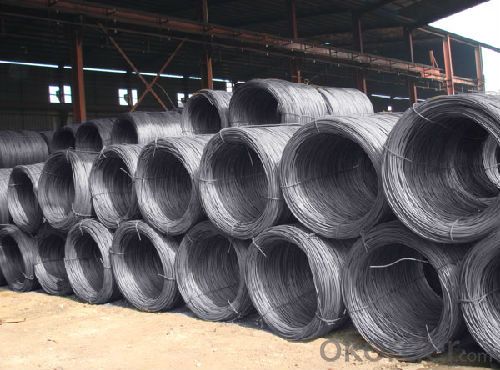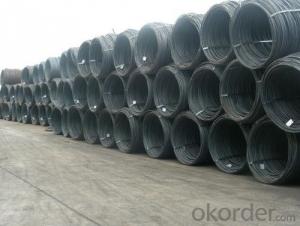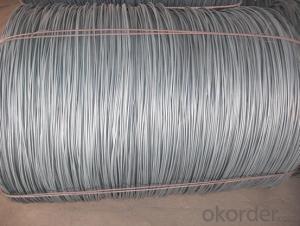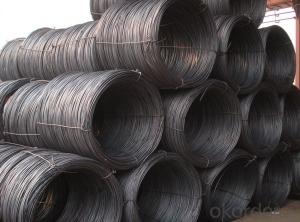Hot Rolled Steel Wire Rod SAE1008B 5.5MM-14MM
- Loading Port:
- Tianjin
- Payment Terms:
- TT or LC
- Min Order Qty:
- 25 m.t.
- Supply Capability:
- 100000 m.t./month
OKorder Service Pledge
OKorder Financial Service
You Might Also Like
Product Description:
OKorder is offering high quality Hot Rolled Steel Wire Rod SAE1008B 5.5MM-14MMat great prices with worldwide shipping. Our supplier is a world-class manufacturer of steel, with our products utilized the world over. OKorder annually supplies products to European, North American and Asian markets. We provide quotations within 24 hours of receiving an inquiry and guarantee competitive prices.
Product Applications:
After hot-rolled the products shaped into coil and delivery as finished product, including round, square, rectangular, hexagonal and so on. Since most of the products are round, it is generally called wire rod. Carbon steel wire rod is widely used in construction and manufacturing. Carbon steel wire rod is mainly used for reinforcement of reinforced concrete and welded structure or reprocessed (roberts , nail, etc.) materials, especially used to produce wire drawing, welding electrode, nails, spring, electronic, precise machinery parts and so on.
Product Advantages:
OKorder's Hot Rolled Steel Wire Rod SAE1008B 5.5MM-14MM are durable, strong, and resist corrosion.
Main Product Features:
· Premium quality
· Prompt delivery & seaworthy packing (30 days after receiving deposit)
· Corrosion resistance
· Can be recycled and reused
· Mill test certification
· Professional Service
· Competitive pricing
Product Specifications:
Manufacture: Hot rolled
Grade: SAE1008 SAE 1006
Certificates: ISO, SGS, BV, CIQ
Diameter: 5.5mm, 6.5mm, 7mm,8mm,9mm,10mm,12mm,14mm, as per customer request
Packaging: Export packing, nude packing, bundled
Grade | Chemical Composition (%) | |||||
C | Mn | S | P | Si | B | |
SAE1008B | 0.10max | 0.32max | 0.045max | 0.040max | 0.30max | 0.0008min |
Mechanical properties | ||||||
Yield strength(N/mm2) | Tensile strength(N/mm2) | Elongation (%) | ||||
≥195 | 350-380 | ≥32 | ||||
FAQ:
Q1: How do we guarantee the quality of our products?
A1: We have established an advanced quality management system which conducts strict quality tests at every step, from raw materials to the final product. At the same time, we provide extensive follow-up service assurances as required.
Q2: How soon can we receive the product after purchase?
A2: Within three days of placing an order, we will begin production. The specific shipping date is dependent upon international and government factors, but is typically 7 to 10 workdays.
Q3: What makes stainless steel stainless?
A3: Stainless steel must contain at least 10.5 % chromium. It is this element that reacts with the oxygen in the air to form a complex chrome-oxide surface layer that is invisible but strong enough to prevent further oxygen from "staining" (rusting) the surface. Higher levels of chromium and the addition of other alloying elements such as nickel and molybdenum enhance this surface layer and improve the corrosion resistance of the stainless material.


- Q:What are the different alloys used in steel wire rod production?
- Some of the different alloys used in steel wire rod production include carbon steel, stainless steel, and alloy steel.
- Q:How is steel wire rod coated for improved performance?
- Steel wire rod can be coated for improved performance through various methods such as galvanizing, zinc coating, or applying a polymer coating. These coatings provide corrosion resistance, enhance durability, and improve the wire rod's overall performance in different applications.
- Q:What are the common production processes for alloy steel wire rod?
- The common production processes for alloy steel wire rod include melting, refining, casting, hot rolling, cold drawing, and heat treatment.
- Q:How is the weldability of steel wire rod evaluated?
- Different techniques and criteria are used to assess the weldability of steel wire rod. An important aspect in evaluating weldability is the chemical composition of the rod. The presence of certain elements, like carbon, sulfur, and phosphorus, can greatly affect how well the material can be welded. The mechanical properties of the wire rod, including tensile strength, ductility, and toughness, are also crucial considerations. These properties can impact the weld joint's quality and integrity. The surface condition of the wire rod is another factor that needs to be evaluated for weldability. Any contaminants or impurities on the surface can have a negative impact on the weldability and lead to defects. Moreover, the welding process and parameters used have a significant role in determining the weldability of the wire rod. Factors like heat input, welding speed, and selection of shielding gas need to be optimized to ensure proper fusion and minimize the risk of defects. Various tests and inspections are conducted to evaluate weldability. This includes visually examining the weld for defects such as cracks, porosity, or incomplete fusion. Non-destructive testing methods like ultrasonic testing or radiography can be used to detect internal flaws or inconsistencies. In addition, mechanical tests like tensile and bend testing are performed to assess the strength and ductility of the weld joint. These tests help determine the overall quality and performance of the welded wire rod. In conclusion, the weldability of steel wire rod is evaluated by considering factors such as chemical composition, mechanical properties, surface condition, welding process, and conducting tests and inspections to ensure the quality and integrity of the weld joint.
- Q:What are the different straightening methods for steel wire rod?
- There are several different methods for straightening steel wire rods, including rotary straightening, roll straightening, and stretching straightening.
- Q:How is steel wire rod used in the manufacturing of wire forms for jewelry?
- Steel wire rod is a primary raw material used in the manufacturing of wire forms for jewelry. It serves as the base material from which various wire forms such as chains, clasps, and pendants are created. The steel wire rod is typically processed through a series of manufacturing techniques, including drawing and annealing, which help to shape and strengthen the wire. Once the wire forms are created, they can be further embellished with beads, gemstones, or other decorative elements to create intricate and unique jewelry pieces.
- Q:What are the different heat treatment processes for steel wire rod?
- There are several different heat treatment processes for steel wire rod, including annealing, quenching and tempering, normalizing, and stress relieving. Annealing involves heating the steel wire rod to a specific temperature and then slowly cooling it to make it softer and more ductile. Quenching and tempering involves heating the steel wire rod to a high temperature and then rapidly cooling it in a liquid medium, followed by reheating it to a lower temperature to achieve a desired combination of hardness and toughness. Normalizing involves heating the steel wire rod to a temperature above its critical point and then cooling it in still air to refine its grain structure and improve its mechanical properties. Stress relieving is a process where the steel wire rod is heated to a specific temperature and then cooled slowly to reduce internal stresses and improve its dimensional stability.
- Q:What are the different surface cleaning methods for steel wire rod?
- There are several surface cleaning methods that can be used for steel wire rods. These methods are designed to remove any impurities or contaminants on the surface of the wire, ensuring its cleanliness and enhancing its quality. Some of the different surface cleaning methods for steel wire rods include: 1. Mechanical cleaning: This method involves the use of mechanical abrasion to remove surface impurities. It can be done through processes such as wire brushing, sanding, or shot blasting. Mechanical cleaning is effective in removing rust, scale, or other loose particles from the surface of the wire rod. 2. Chemical cleaning: Chemical cleaning methods use various chemicals to dissolve or react with contaminants on the wire rod's surface. Acid pickling is a common chemical cleaning method used for steel wire rods, where the wire is immersed in an acid solution to remove oxide layers, scale, or other impurities. Alkaline cleaning is another option, which uses alkaline solutions to remove organic contaminants. 3. Electrochemical cleaning: This method involves the use of an electrical current to remove impurities from the wire rod's surface. Electrochemical cleaning processes, such as electrochemical pickling or electrocleaning, use an electrolyte solution and an electric current to dissolve or dislodge contaminants. This method is often used for stainless steel wire rods to maintain their corrosion resistance. 4. Ultrasonic cleaning: Ultrasonic cleaning utilizes high-frequency sound waves to create microscopic bubbles in a cleaning solution. These bubbles, known as cavitation, implode on the surface of the wire rod, effectively removing contaminants. Ultrasonic cleaning is particularly effective in removing oils, greases, or other organic substances from the wire rod's surface. 5. Steam cleaning: Steam cleaning involves the use of high-pressure steam to clean the surface of the wire rod. The steam's heat and pressure help to dislodge and remove contaminants. This method is often used for wire rods that are heavily contaminated with oils, greases, or other sticky substances. It is important to note that the choice of surface cleaning method for steel wire rods depends on factors such as the type and severity of contamination, the desired level of cleanliness, and the specific requirements of the wire's end application. Each cleaning method has its own advantages and limitations, and it is crucial to select the most appropriate method to ensure the highest quality and performance of the steel wire rod.
- Q:What are the different types of steel wire rod surface defect classification systems?
- There are multiple types of steel wire rod surface defect classification systems, including the American Iron and Steel Institute (AISI) system, the International Organization for Standardization (ISO) system, and the European standard EN 10221 system. These systems categorize surface defects in steel wire rods based on their appearance and severity, allowing for better quality control and identification of potential issues in the manufacturing process.
- Q:Can steel wire rod be used for welding applications?
- Yes, steel wire rod can be used for welding applications. It is commonly used as a filler material in welding processes such as MIG (Metal Inert Gas) welding and TIG (Tungsten Inert Gas) welding. The steel wire rod provides a stable and consistent filler material, ensuring strong and reliable welds.
1. Manufacturer Overview |
|
|---|---|
| Location | |
| Year Established | |
| Annual Output Value | |
| Main Markets | |
| Company Certifications | |
2. Manufacturer Certificates |
|
|---|---|
| a) Certification Name | |
| Range | |
| Reference | |
| Validity Period | |
3. Manufacturer Capability |
|
|---|---|
| a)Trade Capacity | |
| Nearest Port | |
| Export Percentage | |
| No.of Employees in Trade Department | |
| Language Spoken: | |
| b)Factory Information | |
| Factory Size: | |
| No. of Production Lines | |
| Contract Manufacturing | |
| Product Price Range | |
Send your message to us
Hot Rolled Steel Wire Rod SAE1008B 5.5MM-14MM
- Loading Port:
- Tianjin
- Payment Terms:
- TT or LC
- Min Order Qty:
- 25 m.t.
- Supply Capability:
- 100000 m.t./month
OKorder Service Pledge
OKorder Financial Service
Similar products
New products
Hot products
Related keywords




























